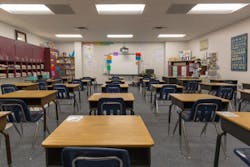Throughout the past few years, we at LEDs Magazine have seen more solid-state lighting (SSL) product development targeted at educational environments. School officials, especially in the public-school arena, must manage strict budgets and plan strategically to obtain the best return on investment (ROI) possible, so the potential financial implications are important factors — first, the cost of premium equipment and installation, but then balanced against the possible payback due to energy efficiency initiatives and less maintenance. One consideration beyond the established cost reductions of SSL in institutional buildings such as schools is the possible impact of tunable white lighting in the classroom. Naturally, dimmability and other controls features such as granularity of color temperature can be customized to various classroom tasks and increase visual acuity. But what’s becoming even more appealing to educational administrators is the ability to influence less “visible” factors in the classroom, such as mood, behavior, and concentration. Strategies in Light, co-located with The LED Show and Lightspace California, will draw more attention to so-called human-centric lighting applications as this, also known as lighting for health and wellbeing. One such presentation, “Lighting for pupils…Tunable white lighting in the classroom and the new ROI,” by Tricia Foster of Acuity Brands Lighting and Catherine Hollenshead of Estes, McClure & Associates (EMA), will feature a case study on a Texas school district’s first-hand experience using tunable white lighting in several classrooms. Here the speakers give a glimpse into the new classroom experience. They will offer up additional details during SIL on how ROI has evolved into “return on objective” (ROO) in such installations. — Carrie Meadows
Tunable white lighting is the future of classroom lighting because of the positive impacts on mood, behavior, and concentration. In a time when schools are seeking every possible advantage to improve the learning environment, they cannot lose sight of the impact lighting and controls can have on learning. Lighting and controls need to be considered tools that are as critical as smartboards, tablets for students, and all the other modern-day teaching tactics that are being deployed in classrooms across the country.
Acuity Brands and EMA will discuss the installation of the tunable white solution in the Carrollton Farmers Branch Independent School District (ISD) where the ROI went beyond energy — showing what it took to bring the energy manager, the teachers, the parents, principal, and even the students along for the ride. In addition, the results of a Pacific Northwest National Laboratories (PNNL) Gateway Study are now public and we will show the results of this study based on the installation at CFB ISD.
LEDs Magazine will continue its countdown to Strategies in Light with more industry insights here at ledsmagazine.com. You can find details on the conference program, speakers, exhibitors, and more at strategiesinlight.com.
Related: Strategies in Light tracks send strong signals about lighting prospects
Tunable white lighting and its potential impact on the K–12 learning environment has been the subject of a number of research studies, but not a lot of practical, in-the-classroom experience exists,” Foster points out. “Catherine and I had the opportunity to work with the school administration, teachers, and students to gain insight and feedback on just how effective lighting can be on student behavior and performance.”
Related: 10 Things to Love about Strategies in Light 2018
“As part of our presentation, we will walk through deploying a tunable white system into the classroom,” adds Hollenshead. “We will review the return on investment from energy savings over the previous fluorescent lighting system, but also dig into the multiple benefits to the teachers and impact on students as they experience lighting that can be adjusted to mood, activity, time of day, and other factors.”
In brief: Carrollton Farmers Branch Independent School District
One classroom in three different schools in the district converted from traditional fluorescent luminaires without any controllability in the spaces to the Lithonia Lighting BLT Series Tunable White luminaire featuring nTune controls technology. The new installation allowed the teachers to control both the intensity and color of the lighting in the classroom based on the task at hand. Teachers had the flexibility to use the pre-programmed settings or manually adjust based on the classroom needs.
The three schools that had classrooms converted to tunable white lighting in August of 2016 are Dale B. Davis Elementary – 5th Grade, Sheffield Elementary – 3rd Grade, and Blalack Middle School – 8th Grade.
Join us on Thursday, Feb. 15, during “Session 5: Choosing the Right White Light,” as we discuss the project parameters and details that determined the solutions required to meet the school district’s goals, and how ROI evolved to achieve ROO in this multi-classroom tunable lighting installation.
TRICIA FOSTER joined Acuity Brands in 1999. As director, market development, she drives demand for total lighting solutions to educational facilities. CATHERINE HOLLENSHEAD began her engineering career with EMA in 2004 and is now lighting specialist at EMA.
Tuning in to more on educational lighting
For another take on the Carrollton school project, read about the Gateway study.
At LightFair International in 2016, Acuity launched tunable lighting for schools and offices.
Learn more about the future-proofing possibilities of tunable white lighting in the classroom.










